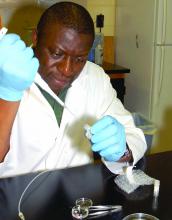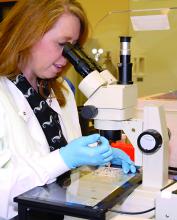Information Possibly Outdated
The information presented on this page was originally released on August 30, 2013. It may not be outdated, but please search our site for more current information. If you plan to quote or reference this information in a publication, please check with the Extension specialist or author before proceeding.
MSU scientists study reproduction mysteries
MISSISSIPPI STATE -- Mississippi State University scientists are working to find out why some pregnancies are successful and others are not.
Jean Feugang, a research assistant professor in the Department of Animal and Dairy Sciences, is studying the reproductive stage that remains one of the most mysterious -- the time just before conception.
“We understand sperm and egg development, and we understand embryo development, but we still lack understanding in between. What factors make one sperm successful and millions or billions fail? Why do some eggs take, but others don’t?” he said. “This research can provide invaluable insight into biological and cellular processes associated with sperm and egg behavior and interactions before early embryo development.”
Feugang is working with two other MSU reproductive biologists, Peter Ryan and Scott Willard. They use nanotechnology to study reproduction issues at the most microscopic level during what Feugang described as the “complex and mysterious biological processes of early life.”
The Mississippi Agricultural and Forestry Experiment Station researchers are using swine for the study. However, their research has applications to all mammals, including humans. Researchers use quantum dots, or nanoparticles, which are absorbed into sperm cells, to track the cells’ movement along the reproductive tract.
“There is a crucial need to understand sperm behavior within the female genital tract and the interactions with the reproductive environment,” he said. “This is like putting a tiny camera into the reproductive system so that we can see what is happening, when and where.”
Ryan said quantum dots have been used for several years in human medicine, primarily to detect cancer and prevent its spread.
“Quantum dots can help doctors see the perimeter of a tumor so they can be sure to remove it all,” he said. “Use in reproduction opens up opportunities in gene therapy, but we are still very early in this research. You have to start at A before you get to Z.”
Ryan said one benefit of the quantum dot method is that it allows researchers to see what is happening in real time. In addition, scientists can make observations without euthanizing the animal.
“The recent development of self-illuminating quantum dot nanoparticles that can interact in the system without causing harm to the animal or embryo is a significant advancement in this field of study,” he said. “Developing noninvasive monitoring techniques after artificial insemination has the potential to improve breeding success rates.”
Compared to traditional dyes, the nanoparticles provide scientists with brighter and clearer pictures of cell activities.
Ryan said their research is attracting international attention and described Feugang as the “Quantum Dot Doc.” Feugang presented at the annual meetings of the International Embryo Transfer Society for two consecutive years and gave another presentation at the Society for the Study of Reproduction. With each presentation, he further establishes MSU as the leader in this reproductive research.
“A number of universities and national and international groups are following MSU into this area of study, but MSU plans to maintain its leadership in this field,” said Ryan, who is MSU’s associate provost.
Willard, who is the head of the MSU Department of Biochemistry, Molecular Biology, Entomology and Plant Pathology, said the researchers want to collaborate with other scientists on campus who are working with quantum dots.
“Quantum dots have a wide variety of applications, including use in biomedical imaging, as light-emitting probes and in nano-reflective strips,” he said. “We could have a network of basic and applied scientists across campus, including engineers, biologists and veterinarians, using the same instruments to conduct a wide variety of research experiments.”
Willard said the use of quantum dots in the area of reproduction is so new that there is minimal research activity underway. MSU’s research is laying the groundwork for this type of imaging in reproductive studies.
“We are still trying to figure out what the technology can do for us and what it cannot do,” he said. “We are discovering how quantum dots can be used in the lab as markers or on a greater scale in an application context. We hope that eventually the quantum dots will be able to carry proteins or other needed material through the body to alter conditions and improve health.”
Researchers received funding for the study through the Biophotonics Initiative Cooperative Agreement in partnership with the Agricultural Research Service of the U.S. Department of Agriculture.




